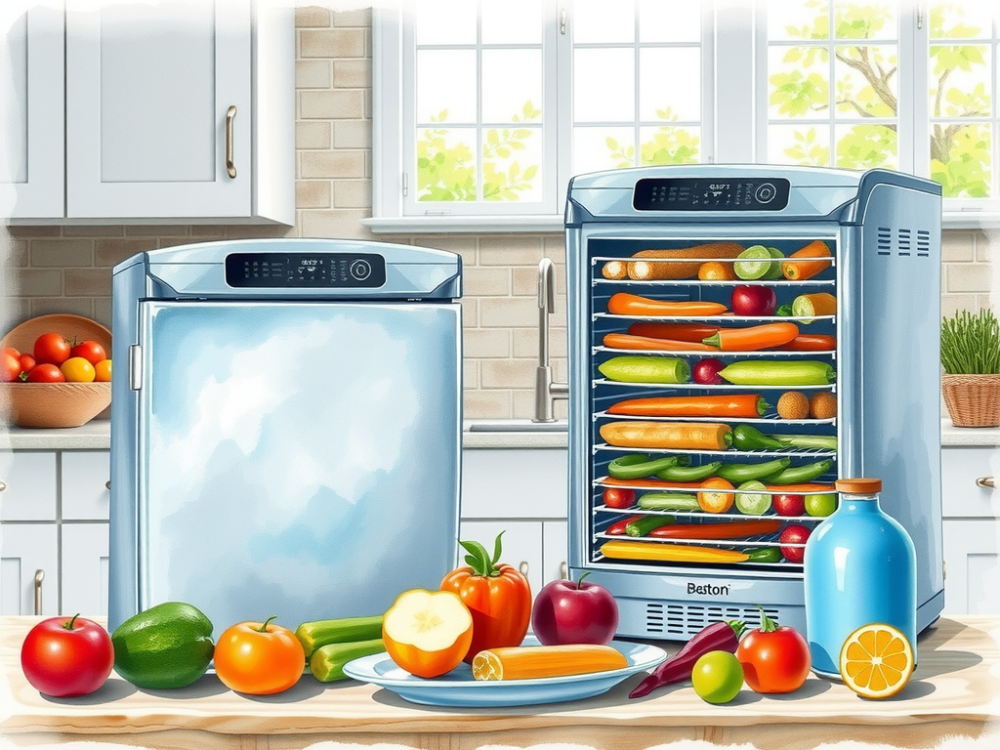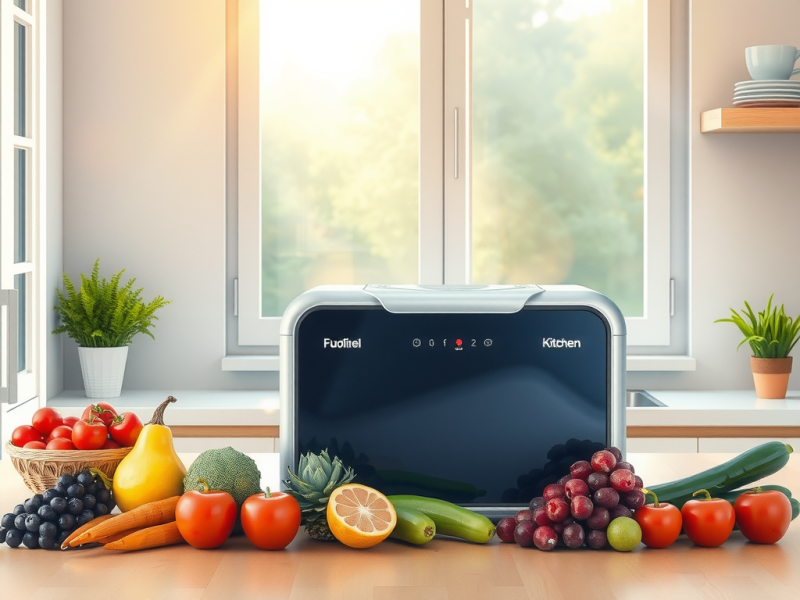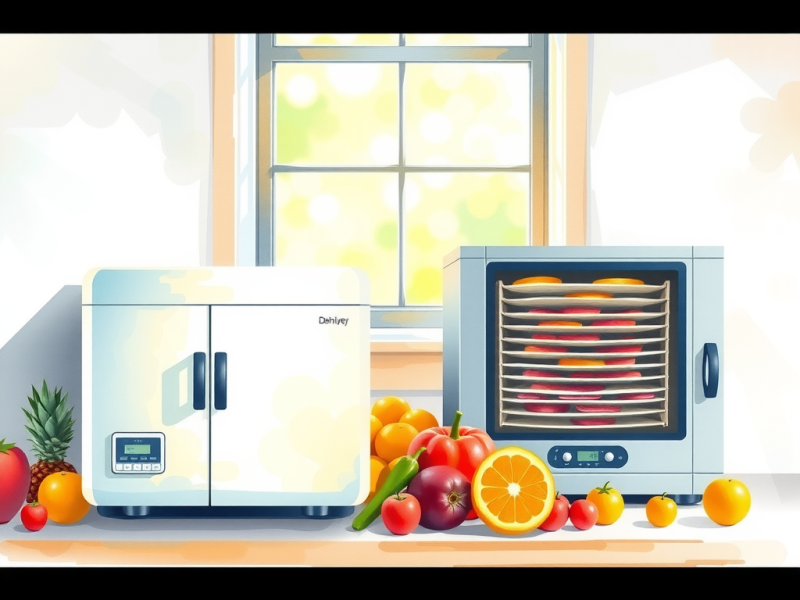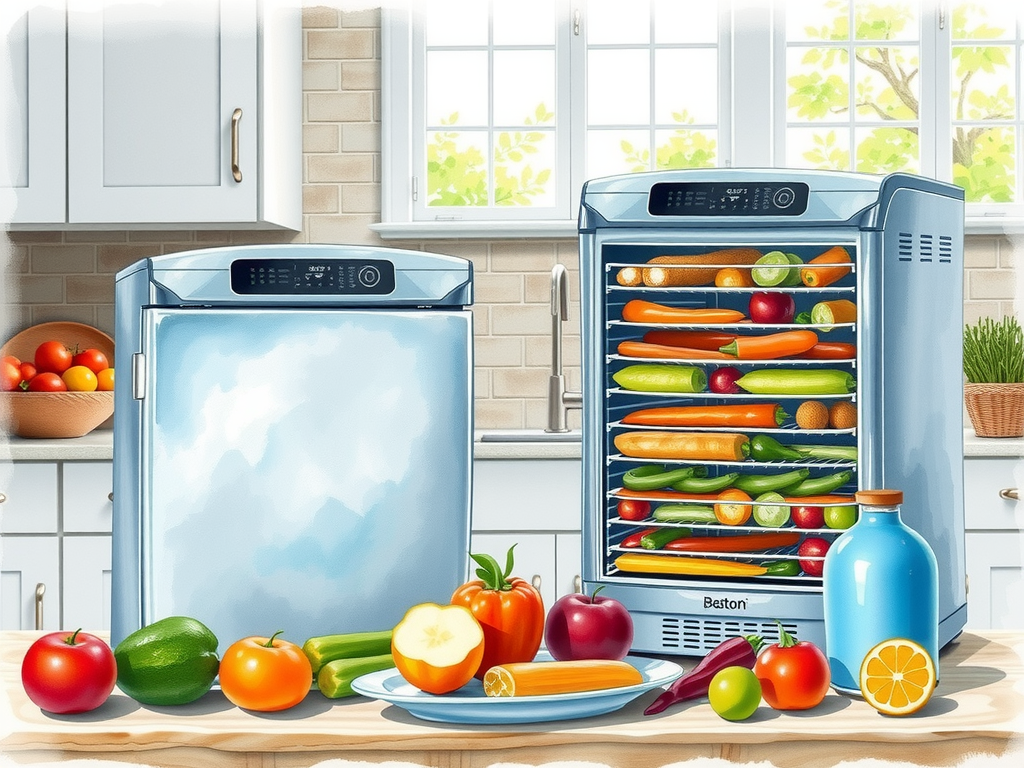
Freeze dryers and dehydrators are popular tools for food preservation. Freeze dryers excel in nutrient retention, preserving up to 97% of vitamins and minerals.
Dehydrators offer cost-effective methods and a user-friendly design.
They can be easily used at home.
Freeze-dried foods keep their natural flavor and original texture, while dehydrated foods become denser and chewier. For long-term storage, freeze dryers keep food safe for up to 25 years, whereas dehydrators succeed for only 1 to 3 years.
Both methods are valuable preservation tools for food drying.
Click here to learn more about: freeze dryer vs dehydrator
Moisture Removal Processes
Moisture removal plays a key role in food preservation. Freeze drying utilizes lyophilization.
This process freezes food and then sublimates ice under vacuum conditions.
It removes up to 99% of moisture, keeping the nutritional quality high.
In contrast, dehydrators use heat, between 95°F and 160°F, to evaporate moisture. This can cause nutrient degradation, especially in heat-sensitive foods.
Dehydration often produces snacks like fruit leathers and jerky, making them popular for camping food. Both methods are suitable for home use and offer unique benefits.
Freeze Dryer Features
- Removes 99% of moisture through freezing and sublimation.
- Retains nutrients, flavor, and original texture.
- Foods can last up to 25 years when stored properly.
- Ideal for high-value foods and emergency food storage.
- Equipment is expensive and energy-intensive.
Dehydrator Features
- Uses heat to evaporate water from food.
- More affordable and energy-efficient.
- Results in tougher textures and some nutrient loss (e. g. Vitamin C).
- Common for creating snacks, jerky, and dehydrated herbs.
- Shorter shelf life, around 1 to 3 years.
Both freeze dryers and dehydrators help in moisture removal and extend food shelf life while preventing microbial growth.
Choosing between a freeze dryer and a dehydrator depends on your needs. Freeze dryers maintain food textures and nutritional quality better, making them suitable for long-term storage. Dehydrators are more affordable and fit for everyday snacks. Each method serves specific purposes in food processing. When selecting a method, consider your culinary applications and storage plans.
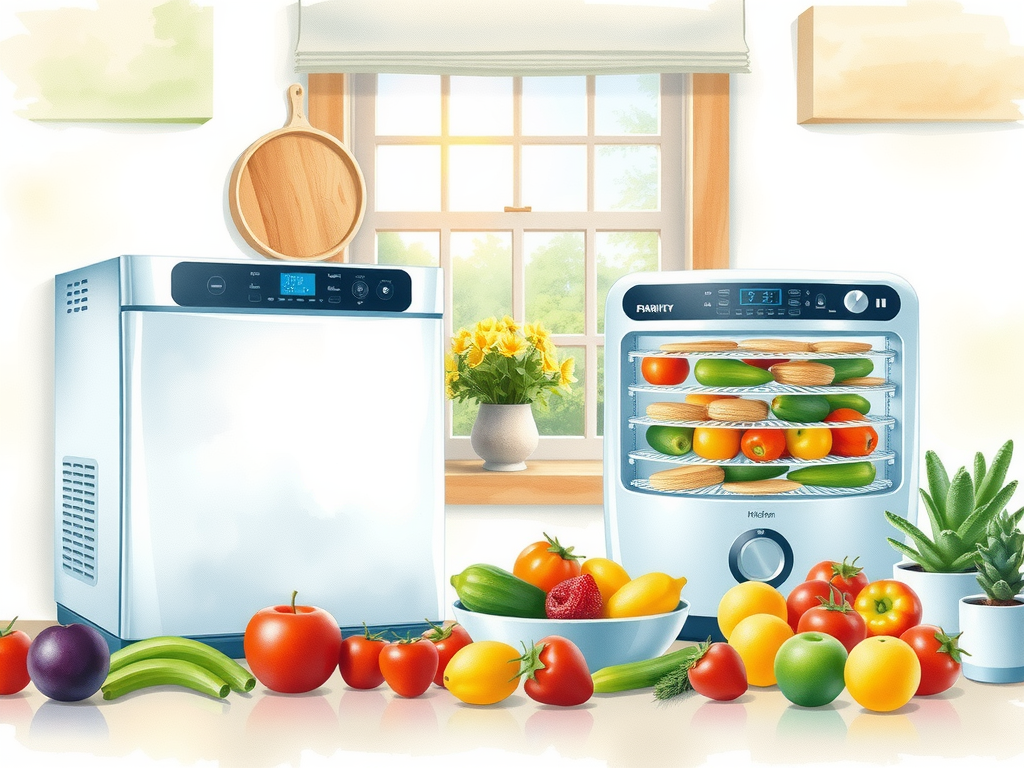
What Is Lyophilization In Detail
Lyophilization, or freeze drying, is an advanced food preservation method that significantly extends shelf life. This technique involves freezing food and removing moisture under vacuum conditions.
During this process, ice undergoes sublimation and transforms directly into vapor, bypassing the liquid state.
This process helps preserve the food’s structure and nutrients.
Research shows that lyophilization retains up to 97% of vitamins and minerals. For maintaining nutrient retention, especially in high-value foods, this method is effective.
In contrast to dehydration, which uses heat and can lead to nutrient degradation, lyophilization keeps flavors and textures intact. It is ideal for emergency food storage and long-term supplies.
Nutrient Retention In Freeze Dried Foods
Freeze drying excels in preserving nutrients when compared to conventional drying methods.
This method can remove up to 99% of moisture while retaining essential vitamins, such as Vitamin C, that often degrade during dehydration.
Freeze drying maintains the cellular structure of foods, which enhances their nutritional quality.
Examples of nutritious freeze-dried foods include:
- Strawberries – Rich in antioxidants and vitamins.
- Spinach – Contains essential nutrients.
These foods not only maintain their natural flavor but also provide vital nutrients. Freeze-dried meals present a convenient option for supporting a healthy diet, even in long-term storage situations.
Differences Between Freeze Drying and Dehydrating
Freeze dryers and dehydrators are common tools for food preservation. Both methods remove moisture to extend shelf life and prevent microbial growth, but they operate differently.
- Freeze Dryer:
- Removes 99% of moisture through freezing and sublimation.
- Retains nutrients, flavor, and original texture.
- Foods can last up to 25 years when stored properly.
- Ideal for high-value foods and emergency supplies.
- Equipment is often expensive and energy-intensive.
- Dehydrator:
- Uses heat (95°F–160°F) to evaporate water from food.
- More affordable and energy-efficient.
- Results in tougher textures and some nutrient loss.
- Typically used for snacks, jerky, fruits, and herbs.
- Shorter shelf life, around 1–3 years.
Lyophilization
- Lyophilization can retain up to 97% of vitamins and minerals in food.
- Freeze drying removes up to 99% of moisture, significantly enhancing nutrient preservation.
- Freeze-dried foods can have a shelf life of up to 25 years when stored correctly.
- Unlike dehydration, freeze drying maintains the food’s original flavor and texture.
Comparing Shelf Life Of Each Method
Freeze dried foods can last up to 25 years when stored correctly. This extended shelf life is due to the 99% moisture removal during the freeze-drying process.
In contrast, dehydrated foods typically last only 1 to 3 years because they retain more moisture.
The importance of moisture removal cannot be overstated; it directly impacts shelf life and reduces the risk of spoilage.
To maximize shelf life in home storage, use airtight containers and keep food in cool, dark, dry places. For longer preservation, consider vacuum sealing to prevent moisture and air exposure.
How Do Drying Techniques Differ
Freeze drying uses low temperatures and sublimation to remove moisture, preserving most nutrients, flavor, and texture.
This method retains up to 97% of the food’s nutrients, making it ideal for high-value foods and emergency food storage. Dehydration uses heat to evaporate moisture, leading to tougher and denser textures.
Nutrient loss occurs, especially in heat-sensitive foods.
Here are key differences:
- Freeze Dryer: Removes 99% of moisture, retaining nutrients and quality.
- Dehydrator: Uses heat (95°F–160°F) to evaporate moisture.
- Cost: Freeze dryers are more expensive and energy-intensive.
- Texture: Freeze drying preserves original textures, while dehydration yields shriveled items.
- Shelf Life: Freeze dried food lasts up to 25 years; dehydrated food lasts 1–3 years.
Choose freeze drying for high-value, nutrient-sensitive foods. Dehydration is suitable for affordable snacks and jerky production. Each method has unique applications, making them suitable for different food preservation needs.
- Freeze dried foods can last up to 25 years when stored in airtight containers and kept in cool, dark, dry places.
- Freeze drying retains up to 97% of the food’s nutrients, making it ideal for preserving high-value foods.
- Dehydrated foods typically last only 1 to 3 years due to higher moisture content and nutrient loss during the drying process.
- Freeze dryers are more expensive and energy-intensive compared to dehydrators, which use heat to remove moisture.
Emergency Food Storage Solutions Explained
Effective emergency food storage relies heavily on moisture removal. Reducing moisture is essential to prevent microbial growth, which spoils food and reduces shelf life.
Choosing the right storage method varies based on emergency scenarios.
For high-value foods, freeze drying is optimal, as it maintains nutrients through sublimation.
Conversely, dehydrators are suitable for everyday items. When selecting a method, consider temperature control and moisture levels to maximize nutrient retention.
Freeze Drying vs.
Dehydration
Freeze drying removes 99% of moisture via freezing and sublimation. This method retains nutrients, flavor, and texture.
Foods can last up to 25 years when stored properly.
It is ideal for emergency supplies or pharmaceutical applications.
Equipment is expensive and energy-intensive.
Dehydration uses heat between 95°F–160°F to evaporate water. This method is more affordable and energy-efficient.
It yields dense, chewy products, although some nutrient loss occurs, especially with vitamin C. Dehydrated foods have a shorter shelf life, about 1–3 years, and are typically used for snacks, jerky, fruits, and herbs.
Exploring Nutritional Quality In Dehydrated Snacks
The method of dehydration significantly affects the nutritional quality of snacks.
This method can reduce vitamins, particularly vitamin C, while minerals and fiber remain intact.
Connecting this to earlier discussions on moisture removal, it is clear that preservation techniques impact health.
Popular Options and Their Benefits
Popular nutrient-rich dehydrated snacks include:
- Dehydrated fruits like apples and bananas
- Vegetable chips made from kale and zucchini
These options offer convenient, nutritious alternatives, ensuring that even high-value foods provide essential nutrients during emergencies.
Dehydrated fruits and vegetables are affordable options that retain fiber and minerals. While some nutrient degradation may occur, many snacks remain a healthy choice. Proper storage and moisture control enhance their longevity.
| Storage Method | Moisture Removal | Shelf Life | Nutrient Retention |
|---|---|---|---|
| Freeze Drying | 99% | Up to 25 years | High |
| Dehydration | Varies | 1–3 years | Moderate (some loss) |
| Dehydrated Fruits | Retains fiber and minerals | 1–3 years | Some nutrient degradation |
| Vegetable Chips | Retains fiber and minerals | 1–3 years | Some nutrient degradation |
Cost Effective Methods For Home Use
Affordable moisture removal techniques are key for effective food preservation at home. Dehydrators and DIY methods offer practical solutions.
These methods can significantly extend the shelf life of fruits and vegetables.
Using Dehydrators
Dehydrators operate at temperatures between 95°F and 160°F to evaporate water from food.
They are budget-friendly and energy-efficient.
This technique creates chewy snacks like jerky and fruit leathers. Though some nutritional quality may be lost, mainly vitamins and minerals, many nutrients remain.
- Results in tough, shriveled textures.
- Typically lasts 1–3 years in storage.
- Great for snacks, fruits, and herbs.
DIY Moisture Removal Techniques
You can also use simple methods like air drying or using a fan. These techniques are low-cost and easy to implement. They help reduce moisture content effectively.
- Air Drying: Leave food in a dry place with good air circulation. This takes longer but uses no energy.
- Fan Drying: Place food in front of a fan to speed up drying time.
Benefits of Moisture Removal
Prioritizing moisture removal enhances food safety by preventing microbial growth. It also preserves the natural flavor and texture of food without high costs. Freeze drying is another option.
While freeze drying removes 99% of moisture, it is costly and energy-intensive. This method keeps most nutrients and maintains flavors. Foods can last up to 25 years when stored correctly.
By using these cost-effective methods, you can enjoy dehydrated snacks and meals with great nutrient retention. They are ideal for home use and can help with emergency food storage.
Moisture Removal Techniques
- Dehydrators can retain up to 80% of the nutrients in fruits and vegetables when used properly.
- Air drying can reduce moisture content by 85% without the use of electricity.
- Properly dehydrated foods can be stored for 1–3 years, making them ideal for long-term food preservation.
- Freeze-dried foods can last up to 25 years when stored in optimal conditions, retaining most of their original flavor and nutrients.

